Paper from
the ninth Australian Conference on Trees and Nut Crops
by Roger Meyer, Valley Vista Kiwi, California

Jujube Orchards
Abstract
Roger Meyer grows commercial crops of Jujubes in California.

Jujube Orchard
Jujubes
are an extremely popular fruit in many parts of the world. The areas
where it is cultivated begin in North Africa and go east, through the
Middle East, to India and Indochina, then northward to China and Korea.
However, it is virtually unknown in Japan.
Jujubes have two basic problems:
1.
Some cultivars are thorny, not as bad as the Kei Apple. They have two
types of thorn, either a hooked thorn or a very straight thorn. Some
are thornless.
2. The other problem is that they do send up root
suckers throughout your field. To me, there are dollar signs on every
one of those. Every winter I dig them up and they are the rootstock for
next year's grafting. If you don't want them, you can hoe them down in
the winter, or mow them down.
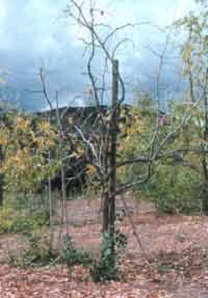
This
is the early branches in the spring time. I have identified five
different branch structures on Jujube. The fruiting canes drop off
every winter. It is not something to worry about. You haven't
underwatered or overfertilised, you haven't done anything wrong when
you see your plant having all these dead little twigs, it is just
natural, and they just fall off.
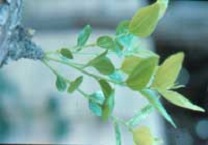
This
is what is called the pinecone. It is a branch that only grows about
one millimetre a year. On the older trees, this is where many of the
fruiting canes arise. You can see the start of the flowers. The flowers
are fairly inconspicuous, little yellow-green flowers with not much
smell.
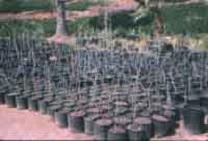
If
you are going to get into the business, you want to get nursery stock
going. You will be several years ahead of everybody else, you might as
well make money by selling plants to somebody who is behind you. These
are my nursery stock plants that I will use and also sell.
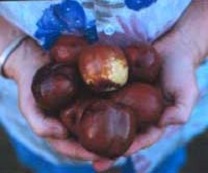
This
is the Li Jujube, one of the best. There are probably a dozen different
ones in China called Li, from different provinces. They are all
similar. They are one of the largest of the Jujube fruits, very
crunchy, nice eating, and one of the earliest. We begin harvesting in
mid-August.
Our phone starts to ring off the hook in late June
with people wanting to know when they are ready. They go from green to
a yellow-green to a deep mahogany red. The red comes on in little spots
like a banana gets black spots when it ripens. The spots slowly
coalesce and take over the fruit. A totally ripe banana becomes jet
black, and this Jujube becomes this deep red or brown colour.
The
time to pick depends on the cultivar. You can pick Li in the
yellow-green stage. It lasts a few days longer on the shelf. It is not
quite as sweet, but it will become sweeter as the carbohydrates turn to
sugars. We pick them in this stage here.
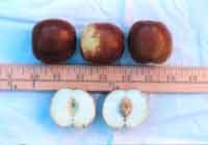
Here
is an example of a Jujube. This is one of the Chinese selections that
one of your WA fellows has brought in through quarantine. It is fairly
large for a Jujube. This would be what the customer wants, this size.
This is a crunchy one, very nice, sweet, and juicy.
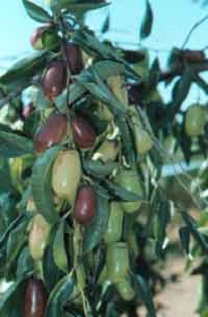
Some
jujubes have round fruits. This one is elongated. This is called the
Silverhill, came out of America, and is a very late-ripening fruit. Not
the best eating one at all, however, since it is so late, in October,
my customers are looking for anything to buy at the time and they will
accept it at that point. If it were competing with any of the other
Jujubes, they wouldn't accept it. You can see the differences in
colour. Here is a bit of the red starting, the Silverhill, you need to
wait until it is completely red before it is very good.

This
is probably what is called the GA866. This came from the fruit
introduction station in California where they named their sections and
subsections and rows. So this one was in section G, subsection A, the
866th plant in that row. Very sweet, up to 45% sugar when it is fresh.
When it is dry, it goes to about 75% sugar.
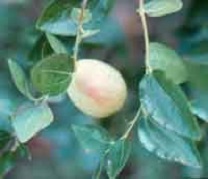
Not sure which variety this is. It is not ready yet, but this is what it looks like hanging from the tree.
The
Lang, at least, what we call Lang in America, is one of the drying
ones. It's OK fresh. You would pick it in the dark red state if you
wanted to eat it fresh. It has the same sugar level, about 25-30%
sugar, but it just doesn't come across as sweet as the Li. So this one
you leave on the tree for drying.
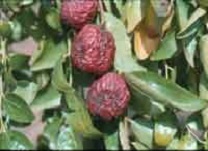
This
is what they look like when they start to dry. They shrivel up. These
are readily available in your local markets: just look in the Asian
food section for Red Dates. Often they are very small. They are also
used medicinally. Some people make tea for sore throats. When they are
dried, they will go up to about 75% sugar, they will dry themselves on
the tree, they don't need any sulfur to preserve them. Once they are
properly dried they need nothing else and they will last forever.

It
is what they look like open. It is still a little bit yellow. If it
were on the tree one day more the yellow would be gone and it would be
all deep red. These are the larger fruit of the Li variety. This is the
size you want to see. The customers just go crazy over this size. It
has a single pit inside. The Li and Lang, the seeds are empty, you
can't plant the seeds. There are other cultivars that do have viable
seeds.

There
can be many fruit like this. The bigger one is about 2 inches wide and
3 inches long. The biggest one I ever grown was 90 grams, almost the
size of a tennis ball.

This
is the way we package them. We get used banana boxes from the local
market for 25 cents each, the cheapest possible packaging. We tried
prepackaging them in 500 gram sizes. What happened was that customers
would break them open to try them to see if they liked them. So we just
do this now.
Responses to audience questions:
There was a fellow from India talking about different aspects of Jujube. The Indian Jujube, Zizyphus mauritiana,
is more tropical than the ones I have. The Indian fruit has a lower
sugar content. It was almost like eating a coconut, in a way. Very
nice, just lower sugar. They will not do well in my area because it is
too cold. You would be borderline here in Perth for growing them. There
are some problems with them being so thorny and getting out of hand. We
have relatives of them in the Americas which don't have edible fruit. I
have often wondered if I can graft on to them.
There is a closely related species called Hovenia dulcis,
the Chinese or Japanese raisin tree, but I have not been able to get
them to cross-graft. We would love to, because they do not send up root
suckers.
I only sell locally. Our Vietnamese population is so
big, that I could produce ten to twenty times the amount and not have
to leave the local area. We started out at $3 per pound. A few years
later we were producing quite a bit more, so we put the price down to
$1.59 per pound.
Fresh fruit is eaten out-of-hand. Dried fruit
is used in cooking. Small dried fruits are used medicinally. There are
hundreds of different medications that are made out of the dried fruit.
A fellow in Texas produces shredded leaves for tea, and shredded fruit
that can be added to cereal.
We don't know how much fruit each
tree produces, because they don't ripen all at once. My guess is that
50 to 100 kg is produced per tree. They can be absolutely loaded. The
trees are drought tolerant, but if you allow them to go through drought
stress, they will drop their fruit. If there is no water available, let
them go. They will survive the summer but will drop their fruit and you
will have to wait until next year.
You have to go through and
hand pick the fruit. We may go through a given tree 6 or 8 times to
pick the fruit. We wait for the right time to pick and then select-pick
in the yellow-green stage. Near the end of the season they start to
ripen faster and faster. Right at the end of the season you are picking
all red fruit. We pick at least twice a week, sometimes three times a
week
The fruit are susceptible to fruit fly. You would have to worry about that, but we don't have them where I am.
Trees
seem to be tolerant to waterlogging as long as it doesn't go on too
long. They also are alkaline-tolerant and saline tolerant. We don't yet
know how much salinity they can tolerate. They were taken to west Texas
in the 1920's for farmers to grow. Their soil there is pH 8.3 and very
salty. They did OK, but they had no market for it. The trees are still
there, but nobody has done anything about them. They don't market them.
Now is an opportunity to market them because they have a huge
Vietnamese population in Houston and Corpus Christi. Our next marketing
area, once we have done all we can in California, is to go to Texas.
There
has been a little bit of competition from other areas into my market.
They have made downward pressure on the price. Other growers tend to
get $1.10 to $1.20 per pound, and that is used against me. I will say,
"Have you tasted that fruit?" "Yes." "Well, is it good?" "No." That
usually ends the question right there. I presume it will eventually
happen and there will be enough production, because I have gone around
as much as I can preaching it. I think it is a marvelous crop, it has a
marvelous potential, especially in areas where nobody else is growing
it at the moment and where you have the population that wants it. And
believe me, they want it. It's your opportunity.
The Italians
know it, and call it something like 'Il Gigolo'. It is generally the
older generation that know it, and they mainly know the little tiny
ones, not the great big Chinese cultivars. There is some debate: look
in the older books, they will say that Jujube came from Syria or North
Africa. You talk to the Chinese and they will absolutely swear that
they developed it. So we just don't know where it actually came from.
There are the Spina-Christa types that are known to come out of Africa.
Those are much smaller fruit with a huge pit in relation to the flesh,
and they are usually not very good. As with many things, the diversity
is very wide. They can be processed with honey to make them more like
what we would call 'Persian Dates.'
I use a wedge graft. I use a
grafter out of New Zealand called the 'Top Grafter.' It is a little
cumbersome but does the job quickly. You can just use a sharp knife. Do
an arrow on the scion. Taking the same diameter as the rootstock, cut a
slice down, put them together, tape them up and let them sit for a
year. They will graft fairly easily. We take the wood in the dead of
winter. It can be stored for four to five months. Keep it refrigerated,
in moist packaging, and it stays just fine.
The scion wood
stores better than the fresh fruit. Fresh fruit has a very short shelf
life. Mine only last about seven days from pickling until it is no
longer salable. Another fellow has exactly the same cultivar I have
because I grafted the trees for him. However, his fruit will store for
three weeks in refrigeration. He is organic and I'm not truly organic,
but I can't believe that is the whole reason. Most of the manure I use
is chicken manure. I really don't know what the two of us are doing
differently. His fruit comes in later than mine, so we don't compete
with each other. He brings down about a ton of fruit in his truck twice
a week, and I sell them for him. I take 13% commission, and I am very
happy.
Back to
Chinese Date Page
|
|













